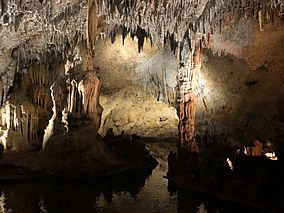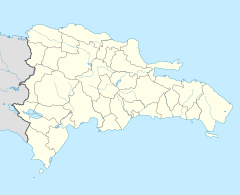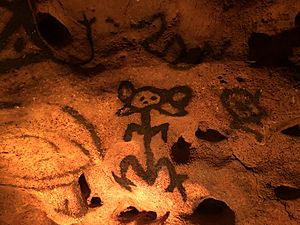Cueva de las Maravillas National Park facts for kids
Quick facts for kids Cueva de las Maravillas |
|
|---|---|
|
IUCN Category II (National Park)
|
|
 |
|
| Location | Dominican Republic
|
| Nearest city | San Pedro de Macorís & La Romana |
| Area | 4.5 square kilometres (1.7 sq mi) |
The Cueva de las Maravillas National Park (which means Cave of Wonders National Park in English) is a special place in the Dominican Republic. It's located in the southeastern part of the country, on the beautiful Caribbean island of Hispaniola. This park is famous for its amazing cave, which holds ancient paintings made by the Taíno people.
The park is about 15 kilometres (9 miles) east of San Pedro de Macorís and 10 kilometres (7 miles) west of La Romana. It's a must-see spot for anyone interested in history and nature!
Contents
Discover the Cave of Wonders National Park
The Cueva de las Maravillas is a national park named after its incredible cave. Before 1949, it was known as the Cueva Jaguar. It's very well-known for the ancient art left behind by the Taíno Indians, who were the first people to live on the island.
The park is found along the road between San Pedro de Macorís and La Romana. It's close to the Soco River and Cumayasa. The cave itself is 800 meters long and goes 25 meters underground. The entire park covers an area of 4.5 square kilometers. This special place was officially made a national park on July 22, 1997.
Ancient Art: Taíno Paintings and Engravings
Inside the Cave of Wonders, you can see about 500 amazing paintings and engravings on the walls. These were created by the Taínos, the original people of the island. They used black and red colors for their art.
Experts have found about 10 petroglyphs, which are designs carved into the rock. There are also 472 pictographs, which are paintings on the cave walls. Out of these paintings, 144 are abstract or mysterious designs. You can also find 135 pictographs that look like human faces. There are 18 animal figures, 41 that combine human and animal shapes, and 38 geometric designs.
Special Features Inside the Cave
The Cave of Wonders has some truly unique attractions. One is the Water Mirror Gallery. This is an artificial lake inside the cave. It reflects the top of the cave like a perfect mirror, creating a stunning view.
Another highlight is The Great Panel. Here, you can see a large cave painting made by the Taínos. This special painting shows a funeral ritual, giving us a glimpse into their ancient traditions.
Nature Around the Cave
The area around the cave is home to many different plants. You can find 48 natural species here. Some of these include arraijanes, guáyiga, yellow caya, lignum vitae, and jasmine. There are also plants like cat's claw, carboy, and Pringamosa.
The cave itself formed in limestone rock. This type of rock is common in the South East Coastal Plain, where the park is located.
How the Cave Got Its Name
In 1926, the cave was first called Cueva Jaguar. But in 1949, a professor named Francisco Richiez Acevedo gave it a new name: Cave of Wonders. He chose this name because of the incredible beauty inside the cave. Visitors can imagine all sorts of figures when they look at the stalactites and stalagmites. These are the rock formations that hang from the ceiling and grow from the floor of the cave. The wide variety of ancient paintings also added to its wonder.
See also
 In Spanish: Parque nacional Cueva de las Maravillas para niños
In Spanish: Parque nacional Cueva de las Maravillas para niños



